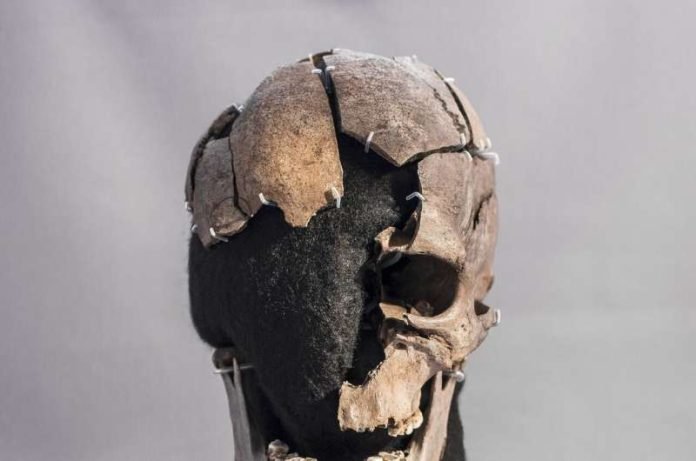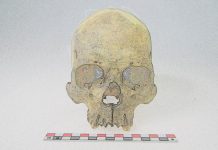
The Vittrup Man, a Stone Age skeleton discovered in a peat bog in Northwest Denmark, has provided groundbreaking insights into the life of people during the transition from the Mesolithic to the Neolithic era.
The study, led by Anders Fischer from the University of Gothenburg, Sweden, and published in PLOS ONE, combines DNA analysis with isotopic studies to offer a detailed reconstruction of Vittrup Man’s life, revealing his origins, movements, diet, and ultimately, his violent death.
Dated to between 3300–3100 BC, the fragmented remains of the Vittrup Man, including a notably smashed skull, suggest he was a victim of ritualistic sacrifice, a practice not uncommon in the region at that time.
The initial DNA analysis distinguished Vittrup Man’s genetic makeup from that of contemporary, local skeletons, prompting further investigation into his past.
The isotopic composition of Vittrup Man’s tooth enamel, specifically strontium, carbon, and oxygen isotopes, pointed to a childhood spent along the Scandinavian Peninsula’s coast.
This finding was further supported by genetic links between Vittrup Man and Mesolithic populations from Norway and Sweden, indicating his early years were spent in a northern foraging society.
Later in life, isotopic and protein analyses of his teeth and bones revealed a significant dietary shift from primarily coastal foods, like marine mammals and fish, to a diet dominated by farm foods, including sheep or goat.
This transition, occurring in his later teen years, marks Vittrup Man’s move to a farming society in Denmark. The reasons behind his relocation remain speculative, with possibilities ranging from trade to captivity, followed by assimilation into the local community.
The study of Vittrup Man not only uncovers the personal history of an individual from over 5,000 years ago but also sheds light on the broader interactions between Mesolithic foragers and Neolithic farmers in Europe.
It highlights the dynamic nature of human societies during this period and the complex web of cultural and economic exchanges that shaped the lives of individuals and communities.
This research stands as a landmark achievement in archaeology, offering an unprecedented level of detail in reconstructing the life history of an ancient European.
It opens new avenues for understanding the intricacies of human history, migration patterns, and cultural transformations during one of Europe’s most pivotal transitional periods.
The research findings can be found in PLOS ONE.
Copyright © 2024 Knowridge Science Report. All rights reserved.



